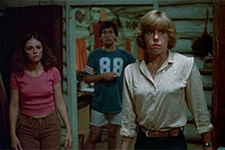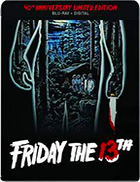Friday the 13th (1980)
|  Warning: This review contains a major spoiler, so if you have not seen Friday the 13th or have any idea how it ends, read with caution. A self-consciously avowed knock-off of John Carpenter’s masterful nightmare Halloween (1978), Friday the 13th has always been a scorned and derided film, with its mixture of shallow characters, boogeyman clichés, and gory spectacle making it an easy target for middlebrow critics to tear to pieces while boisterous teenage audiences lapped it up and asked for seconds (and thirds, and fourths …). Fairly or unfairly, the film’s legacy has made it even more of a target, as it was blamed for igniting a seemingly never-ending cycle of cheaply produced slasher movies that mixed teenage sex and violence with increasingly grisly aplomb while also kick-starting Hollywood’s obsession with sequelitis, which is ironic given that producer/director Sean S. Cunningham never envisioned the possibility of a sequel, much less a franchise that has stretched across three decades. Cunningham had always been an opportunist who was willing to work with any formula that might be popular; the films he directed prior to Friday the 13th were Here Come the Tigers (1978) and Manny’s Orphans (1978), both of which were kid-centric sports movies that were obvious attempts to cash in on the success of The Bad News Bears (1976). He had dabbled in soft-core sleaze during the “porno chic” era (including 1971’s Together, which starred Marilyn Chambers), although he is most notorious for producing the Wes Craven-directed The Last House on the Left (1972), one of the most shocking and talked-about movies of the early ’70s drive-in circuit. Thus, Cunningham knew the intrinsic value of controversy, and Friday the 13th, which he funded independently before getting a distribution deal with Paramount, produced it in droves, particularly when Chicago Tribune critic Gene Siskel made it his personal mission to destroy the movie, not only by lacerating it in his review and encouraging readers to write Paramount chief Charles Bluhdorn and star Betsy Palmer, whose addresses he conveniently supplied, but by joining with Chicago Sun-Times critic Roger Ebert on an all-out media campaign against the slasher subgenre. With the exception of a prologue set in 1958, all of the action in the film takes place over a single day, as a group of counselors arrive at Camp Crystal Lake to set up for the summer, although they spend more time smoking pot, slipping away to have sex, and playing strip Monopoly than they do actually working. The majority of the counselors are played by relative newcomers who are good enough actors, but ultimately went nowhere in Hollywood, with the exception of Harry Crosby, who went nowhere but still has the distinction of being Bing Crosby’s son, and Kevin Bacon, the only actor in the film to develop a genuine movie career (although Friday the 13th is surely the most useless entry in his filmography when playing “Six Degrees of Bacon”). Although often compared to Halloween, Friday the 13th actually has more differences than similarities. The basic formula is the same, but screenwriter Victor Miller, who had co-written Manny’s Orphans, mixes Carpenter’s stalk-and-slash rhythms with an older tradition of rural isolation, thus shifting from suburban nightmare to a folkloric warning about not going into the woods alone. Where the horrors of Halloween are located along the leafy streets of small-town, Midwestern Americana, Friday the 13th takes place at Camp Crystal Lake, an ironically idyllic name for a run-down summer camp located deep in the primeval woods, where the nearest cross-street is 10 miles away, everyone in the closest town looks frightened when the camp is mentioned, and there is even a local crazy who makes proclamations of doooooom. Halloween derives its underlying sense of dread from what we know about the killer, namely that he is an unstoppable force who embodies dispassionate evil in such a way that the only explanation for his rampage is supernatural. Friday the 13th, on the other hand, revels in mystery, giving us a stalker whose identity is not revealed until the final reel, which provides the film’s one true stroke of genius by reversing the Psycho dynamic in making the killer a mother who has internalized her dead son, rather than the other way around. This mystery element also reveals the film to be much more influenced by gialli, the unique Italian subgenre of violent murder-mystery films, particularly Mario Bava’s Twitch of the Death Nerve (1971), a proto-slasher film with 13 murders, several of which are copied almost verbatim in Friday the 13th and Friday the 13th Part 2 (1981). The similarities between the Halloween and Friday the 13th basically come down to the use of an infectiously memorable musical score, which is here provided by Harry Manfredini, who blatantly rips off Bernard Herrmann, but should still be commended for that unforgettable chhh, chhh, chhh, chhh, ahhh, ahhh, ahhh, ahhh motif, and the killer point-of-view, which has been consistently overstated as a means of encouraging the audience to identify with the killer. While such a critique holds true with some later slasher films, in both Halloween and Friday the 13th (as well as Bob Clark’s often undervalued, but deeply influential 1974 film Black Christmas) it is clearly used as a means of concealing an identity, similar to Hitchcock’s use of the extreme high angle when Mother comes out of the bedroom to meet Arbogast at the top of the stairs. Granted, Cunningham’s heavy reliance on the POV as a means of maintaining a sense of mystery eventually borders on the lazy, but it works in its own right and is complicated later in the film when he uses it almost exclusively from the various victims’ perspectives. One other similarity is the use of the “Final Girl,” who is defined primarily by her intelligence, morality, and resourcefulness and who invariably winds up taking down the killer, often with his (or, in Friday’s case, her) own weapon. The Final Girl in Friday the 13th is Alice (Adrienne King), and although she does toke on a joint at one point, she remains squarely tomboyish and virginal. Her eventual showdown with Mrs. Vorhees (veteran TV actress Betsy Palmer), the raging-mad matriarch who has made it her life’s work to keep the camp from ever opening again after the accidental drowning of her adolescent son, Jason, veers just on the edge of high camp before concluding with one of screendom’s great decapitations, which, like all of the film’s effects work, was created by Tom Savini, then best known for his collaborations with George A. Romero (especially 1978’s Dawn of the Dead). Other films have certainly surpassed Friday the 13th in bloodshed, but Savini’s work here has a kind of roughshod ingenuity that can only be attained when working on the edges of current possibilities. More clever than sadistic (note the lack of drawn-out suffering, which is so typical of today’s horror), the film’s various murders revel in their “gotcha” quality, the most memorable being the well-mounted case of indirection that makes Kevin Bacon’s arrow-through-the-throat such a shocker-surprise. When compared to early 21st-century horror movies as defined by the Hostel and Saw series, the original Friday the 13th seems downright tame, if not genuinely classical with its stripped down, campfire-tale aesthetic. And that is, ultimately, what the film is: a campfire boogeyman story designed to do little more than build tension and deliver a few well-timed shocks, which it does with precision and even a bit of artistry. It’s certainly easy to knock Friday the 13th for its various faults, but what those criticisms usually boil down to is an assault on its limited aspirations. Sure, it doesn’t do a whole lot, but what it does do it does quite well.
Copyright © 2020 James Kendrick Thoughts? E-mail James Kendrick All images copyright © Paramount Home Entertainment | |||||||||||||||||||||||||||||
Overall Rating: 

 (3)
(3)


